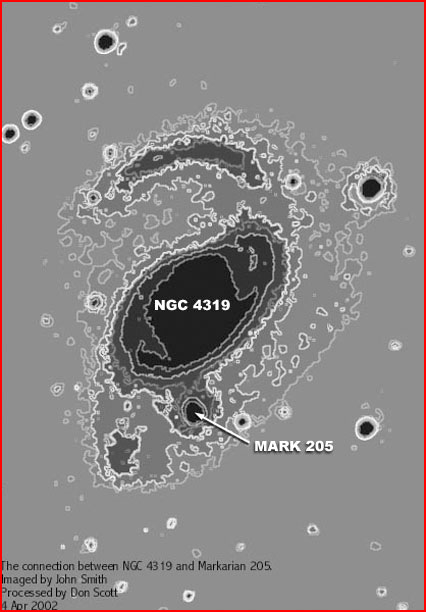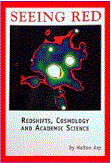|
|
||
 Credit and copyright: John Smith, Hidden Loft Observatory, Don Scott |
||
|
pic of the day Links:
Society for
Redshifts, Cosmology and Academic Science Order Link $25.00
|
Sep 14, 2004 For 80 years cosmology has
been cascading down a riverbed carved through disciplines and
institutions, careers, funding and journals. It began with an
assumption now proven false by the image above, and it must begin
again from its source in empiricism and flow in another direction.
All that's counted as known -- the Big Bang, the expanding universe,
the structure of the cosmos--must be left as a d The image above, taken by amateur astronomers through a medium-sized backyard telescope, shows a low-redshift galaxy (NGC 4319) connected to a high-redshift quasar (QSO) (Markarian 205). Astronomer Halton Arp first brought attention to the importance of the connection in 1971. The filament of light between the two objects contradicts the foundational assumption of modern cosmology: that redshift is a measure of distance, i.e., the greater the redshift the farther away an object is. Because these two objects are physically connected, they must be at the same distance. Their discrepant redshifts must be due to some other cause not related to distance, to some cause intrinsic to the objects. Since 1971, hundreds of such connections have been discovered. Many are congregations of several QSOs scattered along a galaxy's axis like roman candles. The institutions of conventional astronomy have devoted much time to denying the connections exist, but, as with this image, amateurs routinely take pictures of the things the professionals can't see. If redshift is not a measure of distance then galaxies are not systematically receding from each other, the farther the faster. If redshift is not a measure of distance then the universe is not expanding, and it can't be "run backwards" to a primordial Big Bang. If redshift is not a measure
of distance then QSOs are not located at the far ends of the
universe, and they are not "ultraluminous". Clusters of galaxies are
not stretched out into "fingers of God" pointing at the Earth. The
structure of the universe doesn't have "walls" of galaxies or
"bubbles and voids" or "redshift deserts". Because our mental map
of the universe has been drawn with the ruler of redshift, the
breaking of that ruler means that we don't know--again--how the
universe is structured. We must turn away from our Although the headwater of modern cosmology has run dry, it may take a generation or two for the waters of habit to stop flowing and the winds of change to silt in the channel. A number of conjectures for an intrinsic redshift mechanism have been proposed; none are as yet convincing. We may be bold and predict that quantum and particle physics may find their flows diverted, too. A new river of theory will likely not start to flow until an experimentally verifiable mechanism is discovered. Then we will know again--but surely only for another brief time--the architecture of the visible universe. [See Arp's lecture video, "Intrinsic Redshift," for more details of this new picture of the universe.] Available from Mikamar Publishing |
|
|
Copyright 2004: thunderbolts.info |
||

